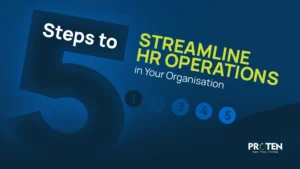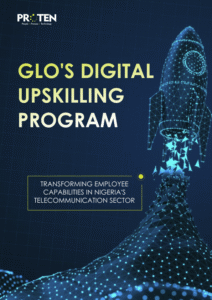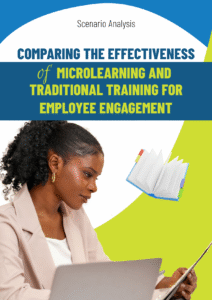As an HR practitioner, you play a pivotal role in sculpting the future of work. Your purpose is to enable the people in your organization to succeed. With constantly changing business models, you have become the focus of your organization and have the power to influence growth and success. Unsurprisingly with great power comes great responsibility. Your unit functions contain so much depth, and each shift in your organization comes with a recurring complex set of challenges regarding work practices, employee expectations, and the global business landscape.
The effectiveness of HR professionals and the success of your company as a whole is impacted by a variety of challenges and issues. Some of these issues are widespread and present in all businesses, regardless of size, sector, or location. It’s critical to recognize and address these HR issues as soon as possible to prevent more harm from escalation. This article will cover 10 common HR issues you need to eliminate, and strategic ways to overcome them.
Why You Should Deal With HR Challenges
Ignoring challenges can have serious consequences that ripple throughout your work environment and beyond. Here’s why you shouldn’t put off dealing with them:
Firstly, unresolved HR issues can lead to a toxic work environment. Unfair treatment, harassment, or unresolved conflicts between colleagues can create a tense and unpleasant atmosphere. This can plummet your employees’ morale, leading to decreased productivity, increased absenteeism, and even higher turnover. When employees feel unsupported or undervalued, they’re less likely to go the extra mile or feel invested in the company’s success.
Secondly, HR problems can expose your company to legal risks. From discrimination complaints to wage and hour violations, failing to address employee concerns can lead to lawsuits and hefty fines. Even if you win a lawsuit, the legal battles themselves are expensive and time-consuming. HR departments are trained to navigate these complexities and ensure the company complies with labor laws, protecting you from avoidable legal trouble.
Thirdly, unresolved HR issues can damage your employer’s brand. Word travels fast, and disgruntled employees might leave negative online reviews or spread their experiences through word-of-mouth. This can make it harder to attract top talent in the future. A strong employer brand built on fairness and a positive work environment, however, attracts qualified candidates who contribute to the company’s success.
Finally, dealing with HR problems head-on demonstrates strong leadership. It shows your employees that you value their well-being and are committed to creating a fair and respectful workplace. This fosters trust and loyalty, leading to a more engaged and productive workforce. By addressing issues promptly and fairly, you can create a positive work environment where everyone feels comfortable raising concerns and contributing their best.
What are The Most Common HR Challenges?
As mentioned before, your purpose as an HR practitioner is to enable your organization to succeed. Anything standing in the way of that is an obstacle. Here are 10 of the most common obstacles you may find in your practice, along with ways to overcome them.
1. Attracting Top Talent
Not only is competition the most significant aspect of business and customer relations, but it is also the most powerful and dangerous factor in human resources, making it particularly challenging for your business that attract people against other well-known names and brands. Attracting top talent is a complex issue that falls squarely on your shoulders. In today’s competitive job market, qualified candidates have their pick of opportunities. As an HR manager, you need to understand what top talents want and translate that into a compelling employer brand. This involves a deep understanding of the current talent pool, their motivations, and what differentiates your company from competitors. It’s your responsibility to craft a strategic recruitment process that effectively attracts these high performers.
Here’s how you can overcome this challenge:
- Clearly define what “top talent” means for your specific roles. Identify the skills, experience, and cultural fit that make someone a perfect candidate for your company.
- Develop a compelling employer brand. Identify what makes your company unique and attractive to top talent. This could be a positive work culture, competitive compensation and benefits, or exciting growth opportunities.
- Streamline and modernize your recruitment process. Ensure your job postings are clear and concise, highlighting the perks and opportunities that top talent craves. Utilize modern recruitment tools and platforms to efficiently find and connect with qualified candidates.
- Focus on the candidate’s experience. From the initial application to the interview process, make sure all interactions showcase your company’s positive culture and values. Establish clear communication channels and provide timely updates to candidates throughout the process, leaving a lasting impression.
- Leverage employee referrals. Your existing happy employees are a fantastic source of top talent. Partner with HR to establish an employee referral program that incentivizes them to recommend qualified individuals from their network.
2. Work Culture Fit
Job and culture fit might pose a complex challenge for you because it requires balancing the need for skilled talent with building a cohesive and thriving work environment. On one hand, focusing solely on cultural fit can lead to a homogenous workforce. This lack of diversity stifles innovation and creativity, hindering the company’s ability to adapt and grow. Additionally, an over-emphasis on cultural fit can mask unconscious bias, potentially excluding qualified candidates who may bring valuable perspectives to the table.
On the other hand, neglecting cultural fit can lead to high turnover and low employee engagement. When employees feel like outsiders or their values clash with the company’s, they’re less likely to be productive or invested in their work. This can create a toxic environment with low morale and communication breakdowns.
Here’s how you can overcome this challenge:
- Clearly define your company culture: Articulate your company’s core values, mission, and work style. This clarity allows you to attract candidates who resonate with your culture without resorting to a narrow definition of “fit.”
- Focus on skills and potential over cultural conformity: Prioritize skills, experience, and growth potential when evaluating candidates. Look for individuals who can contribute diverse perspectives and experiences while still aligning with your core values.
- Develop a structured interview process: Use behavioral interview questions that assess a candidate’s past experiences and how they would handle situations relevant to the role and company culture.
- Incorporate cultural assessment tools: Consider objective assessments that evaluate a candidate’s work styles and values, providing data alongside traditional interviews.
- Prioritize onboarding and team building: Invest in a strong onboarding process that integrates new hires into the company culture and fosters connections with colleagues.
3. Change Management
Change management is deeply intertwined with HR because it fundamentally impacts your most valuable asset – your people. Even if it’s positive, change can trigger resistance, fear, and uncertainty in employees. This can manifest in decreased morale, lower productivity, and even increased turnover. As an HR professional, you’re on the front lines of managing your employees’ reactions. You need to understand the human aspect of change and proactively address those concerns.
Here’s how you can overcome this challenge:
- Be a Change Champion: Advocate for clear communication from leadership about the “why” behind the change. Help translate strategic goals into tangible benefits for employees. This fosters understanding and reduces resistance.
- Communication is Key: Develop a comprehensive communication plan that keeps employees informed throughout the process. Use multiple channels, address concerns openly, and be transparent about timelines and expectations. Regular updates foster trust and a sense of control.
- Focus on People: Develop change management strategies that address the human side of the equation. Offer training and development opportunities to equip employees with the skills they need to thrive in the new environment. Implement effective change management models that consider employee psychology and provide support throughout the transition.
- Employee Feedback Mechanisms: Create safe spaces for employees to voice their concerns and offer suggestions. Conduct surveys and focus groups to understand employee sentiment and tailor your approach accordingly. By actively listening and addressing feedback, you demonstrate that employee voices matter.
- Change Management Expertise: Stay up-to-date on best practices in change management. Consider partnering with a change management specialist to develop a comprehensive strategy.
4. Compensation and Benefits
Compensation and benefits (comp & ben) can be a multifaceted HR problem, impacting everything from attracting and retaining talent to employee morale and productivity. In a tight labor market, offering uncompetitive salaries and benefits packages makes it difficult to attract top talent. You might lose qualified candidates to companies with more attractive offers, hindering your ability to build a strong team. In addition to this, unfair pay structures or limited benefits packages can lead to feelings of dissatisfaction and demotivation among your existing workforce. This can manifest in decreased productivity, increased absenteeism, and a higher likelihood of employees seeking opportunities elsewhere.
Then there is the issue of compliance. Navigating complex wage and hour laws, ensuring equal pay for equal work, and managing benefit plans can be a minefield. Non-compliance can lead to legal repercussions and damage the company’s reputation.
Here’s how to overcome these challenges:
- Market Analysis: Stay updated on industry benchmarks for salaries and benefits. Conduct regular market surveys to ensure your comp & ben package remains competitive within your location and industry.
- Transparency and Communication: Communicate your compensation philosophy to employees. Explain how pay decisions are made and how benefits work. Open communication fosters trust and helps employees understand the value of their total rewards package.
- Tailored Benefits: A one-size-fits-all approach might not work. Consider offering flexible benefit options allowing employees to choose plans that best suit their needs. This demonstrates that you value their well-being and can boost satisfaction.
- Performance-based Incentives: Link compensation to performance to motivate employees and reward high achievers. This can come in the form of bonuses, stock options, or other performance-based rewards, driving a culture of excellence.
- Compliance Expertise: Stay informed on legal updates regarding wages, benefits, and non-discrimination practices. Partner with legal counsel and utilize HR resources to ensure compliance with all regulations.
5. Upskilling Your Workforce
Upskilling your workforce presents a unique challenge for you, but it’s also an opportunity to significantly impact your organization. The first hurdle lies in accurately assessing the current skill sets of your employees and identifying the specific skills needed to achieve your organization’s goals. This requires collaboration with various departments to understand future needs and potential disruptions due to technological advancements. Once the skill gaps are clear, designing a comprehensive upskilling program that caters to different learning styles, time constraints, and career aspirations is crucial. This might involve a mix of online courses, on-the-job training, mentorship programs, or even tuition reimbursement for relevant certifications.
Convincing employees to invest time and effort in upskilling can be difficult. You need to effectively communicate the benefits of upskilling, such as career advancement opportunities, increased job security, and a chance to contribute more meaningfully to the organization.
Furthermore, upskilling programs come with a cost, from trainer fees to employee time away from their usual duties. Striking a balance between effectiveness and affordability is essential. Here, exploring partnerships with educational institutions or leveraging free online resources can be helpful.
Finally, tracking the effectiveness of your upskilling programs is vital. Analyzing post-training performance metrics, employee feedback, and internal talent mobility rates will help you refine your approach and demonstrate the program’s value to leadership.
By proactively addressing these challenges, you can turn upskilling into a powerful tool for HR. Embrace data-driven decision-making, involve department heads in the planning process, and prioritize clear communication with your workforce. A successful upskilling program not only benefits the organization but also empowers employees and fosters a culture of continuous learning.
6. Performance Management
Performance management can be a tricky problem for HR professionals like yourself for a few reasons. One major hurdle is the tendency for these systems to become bureaucratic and paper-heavy. Annual reviews, often filled with generic feedback and lagging behind actual performance, can feel pointless to both managers and employees. This lack of clear expectations and ongoing feedback leaves your employees unmotivated and unsure of how to improve.
Another challenge is rater bias. Unconscious biases can creep into performance reviews, leading to unfair evaluations that don’t reflect reality. This can be especially detrimental for diverse workplaces where unconscious biases can lead to missed opportunities for talented individuals. Finally, traditional performance management often focuses solely on corrective measures for underperforming employees, neglecting the importance of development and growth for all staff.
Here’s how you can overcome these obstacles:
- Focus on revamping the system to be more frequent, relevant, and development-oriented. Move away from annual reviews and implement regular check-ins with clear goals and expectations. Encourage two-way communication where employees can actively participate in setting goals and receive ongoing feedback.
- Tackle rater bias through training for managers on recognizing and mitigating unconscious biases in their evaluations. Consider using standardized evaluation tools and involving HR in the review process to ensure fairness and consistency.
- Shift your focus from punishment to development. Performance management should be a tool to identify areas for improvement and provide growth opportunities. Offer training programs, and mentoring opportunities, and create a culture of learning within the organization. By implementing these changes, you can transform performance management from an HR headache into a valuable tool for boosting employee engagement, motivation, and overall company performance.
7. DEI
DEI (Diversity, Equity, and Inclusion) goes beyond just an HR problem; it’s a strategic business imperative. However, HR plays a pivotal role in overcoming the challenges associated with achieving a truly diverse, equitable, and inclusive workplace. Here’s why DEI is intricately linked to HR and how you can be a champion for progress:
Firstly, unconscious bias can creep into various HR processes, hindering DEI efforts. From job descriptions that unintentionally favor certain backgrounds to interview practices that lack structure, these biases can lead to a homogenous talent pool. HR can tackle this by implementing unconscious bias training for themself and hiring managers, utilizing standardized interview questions, and diversifying interview panels.
Secondly, recruitment strategies often fall short of attracting a diverse candidate pool. You can overcome this by expanding your recruitment channels to target diverse professional networks. Highlighting the company’s commitment to DEI in job postings and showcasing a diverse workforce through employer branding materials can also attract a wider range of qualified candidates.
Thirdly, retention of diverse talent requires an inclusive work environment. HR can foster inclusion by creating Employee Resource Groups (ERGs) that support and empower underrepresented groups. Additionally, implementing clear policies against discrimination and harassment, along with robust reporting mechanisms, ensures employees feel safe and valued. Regularly reviewing and updating company policies to reflect current best practices in DEI is also crucial.
Finally, measuring progress is key to achieving sustainable DEI goals. HR can track diversity metrics throughout the employee lifecycle, from recruitment to promotion rates. Regularly analyzing this data allows you to identify areas where improvement is needed and tailor DEI initiatives accordingly.
8. Labour Laws and Compliance
Labour laws and regulations are constantly changing, with new legislation emerging and existing ones being updated. Keeping up-to-date on these changes across federal, state, and sometimes even local levels requires significant effort and ongoing research. Even with a firm grasp of the law, interpreting and applying it to specific workplace situations can be tricky. Grey areas and nuances can lead to confusion, especially when dealing with novel issues like remote work or employee classification.
In addition to this, HR departments are often stretched thin, juggling multiple priorities. Dedicating sufficient time and resources to staying abreast of legal updates and ensuring compliance can be difficult. Failure to comply with labour laws can lead to hefty fines, back pay awards, and even lawsuits. These legal issues can be costly, time-consuming, and damage the company’s reputation.
Here are ways to overcome these challenges:
- Stay Informed: Subscribe to reliable legal updates or partner with legal service providers who specialize in labour law. Attend workshops and training sessions to keep your knowledge current.
- Develop Internal Expertise: Dedicate time within your HR team to develop expertise in labour law compliance. This could involve assigning someone to be the point person or encouraging team members to pursue relevant certifications.
- Invest in Compliance Tools: Utilize HR software or online resources that can help you track compliance deadlines, manage employee records, and automate some processes.
- Proactive Communication: Regularly communicate company policies and employee rights to your workforce. Encourage open communication so employees feel comfortable raising concerns about potential compliance issues.
- Seek Guidance: Don’t be afraid to seek internal legal counsel or consult with external labour law specialists when faced with complex situations.
9. Leadership Development
Identifying high-potential leaders can be tricky. Traditional methods like performance reviews might not capture the specific qualities needed for strong leadership. You’ll need to create a multi-faceted assessment process that considers factors like emotional intelligence, strategic thinking, and the ability to inspire and motivate others. Secondly, there’s a constant need to tailor development programs. Leaders at different levels require distinct skill sets. Junior leaders might need coaching on delegation and communication, while senior leaders might benefit from strategic planning and navigating complex business situations. A one-size-fits-all approach won’t be effective.
In addition to these, securing buy-in from leadership itself can be difficult. Busy executives might perceive development programs as time-consuming and unnecessary. You’ll need to demonstrate the clear ROI (Return on Investment) of leadership development programs by showcasing how they can improve employee engagement, retention, and overall business performance.
Furthermore, there’s the challenge of creating a culture of continuous learning. Leadership development shouldn’t be a one-time event. Encourage ongoing learning through mentorship programs, online resources, and opportunities for leaders to share best practices and learn from each other.
Here’s how you can overcome these challenges:
- Partner with business leaders to define the specific leadership competencies needed for success in your organization.
- Develop a multi-pronged approach to leadership development, incorporating coaching, workshops, mentoring programs, and experiential learning opportunities.
- Gather data to demonstrate the impact of leadership development programs on key metrics like employee engagement and retention.
- Foster a culture of learning by offering ongoing development opportunities and recognizing leaders who continuously seek to improve themselves.
10. Data Security and Integrity
HR data fuels critical decisions. From recruitment and performance management to payroll and legal compliance, accurate information is essential. Inaccurate data can lead to misinformed decisions, like hiring the wrong candidate, underpaying an employee, or missing important deadlines. This can have a domino effect, impacting employee morale, productivity, and even legal repercussions.
Secondly, HR data often comes from multiple sources. Employee self-reporting during onboarding, manager updates on performance, and external background checks all contribute to an employee record. This creates a risk of inconsistencies, typos, or missing information if proper protocols aren’t in place.
Thirdly, the sheer volume of HR data can be overwhelming. With a growing workforce, the amount of information managed by HR expands. Manual data entry processes are prone to errors, and outdated systems might not be equipped to handle complex data sets effectively.
Here’s how you can overcome these challenges:
- Implement a robust HRIS (Human Resource Information System): An HRIS streamlines data collection, storage, and management. It can automate tasks, enforce data entry rules, and provide easy access to employee records for authorized personnel.
- Standardize data entry procedures: Establish clear guidelines for how information should be entered and updated in the system. This reduces inconsistencies and ensures everyone follows the same protocols.
- Regularly audit and clean your data: Schedule data audits to identify and rectify any errors or missing information. Encourage employees to keep their personal information updated through self-service portals within the HRIS.
- Train your team on data security: Educate HR personnel on data privacy regulations and best practices for securing sensitive employee information. Implement access controls within the HRIS to ensure that only authorized personnel can view and modify data.
In Conclusion…
HR issues are prevalent in all organizations. With the appropriate approaches and resources, they can be resolved, therefore there is still hope. Effective HR management may enhance the performance, culture, and reputation of your company. In addition to adhering to best practices, you may use an ATS to automate the hiring process, enhance your employer’s brand, and make sure the correct candidates are filling open positions in order to tackle HR difficulties.










